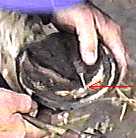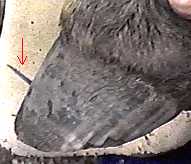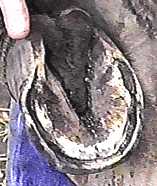|
We decided to test the theories presented by Dr. Bowker and Mr. Ovnicek. We took six horses of which we knew the history and used them in our informal trials. Each horse had a particular problem which to we were well accustomed and we hoped to see what transpired after application of four point trims or natural balance shoeing.
Four horses that were usually kept barefoot were trimmed. One was a quarter horse who had a stumbling problem. One was a quarter horse which tended to grow long toes with poor heels and who was getting worse. One was a foxtrotter who ordinarily would gait well without shoes but who was behaving erratically at certain gaits for no medical reason. The last was a Belgian Draft Horse who tended to get quarter cracks when barefoot.
The horses are kept in sand pastures or sandy paddocks and the winters in this region were typically rainy with wet ground present from November through May with the ground hardening occasionally in late spring as the rains became less frequent. Summers are totally arid until early November.
The intent of this experiment was to see if more natural trimming would encourage normal hoof development and we would follow the progress of these horses and see if the problem symptoms diminished over the 1998 season. They were trimmed on January 28, 1998. This document will be updated as time goes on and we have something to report.
|
The most significant horse we wish to illustrate at this time is the QH with the long toe, poor heel problem. We videotaped his trimming and here were our initial findings:
It is important to realize just how much excess toe is present in most domestic horse feet which is not present in the feet of wild horses. Bowker and Ovnicek presented slides and radiographs where nails were driven up through the soles of horses' feet at the point of proper break-over and the images were astounding. Therefore we decided to repeat this experiment with our long toed candidate.
|

|
|
(Please don't try this at home!)
I measured 1 1/4" forward of the apex of the frog and drove in a horseshoe nail. Needless to say I was kind of anxious about this, although the horse couldn't have cared less. To him it felt no different than nailing on a shoe, except that I was nailing into the toe rather than into the sidewall. When one first views this image, it appears that the nail must be going through the pedal bone. Stay tuned.
| 
|
|
We removed the nail so we wouldn't get caught on it, but inked the holes for easier spotting later. Then we set about leveling the sole. We left as much sole as possible, not trimming below the waxy layer and we also left the frog alone. One of our primary concerns was the horse's heel problem. This horse was obviously distributing weight well ahead of center and this problem needed to be addressed. We wanted to keep as much heel as possible but broaden the base of support so that the bars and other structures would share the load and permit the heels to grow more correctly.
|

|
|